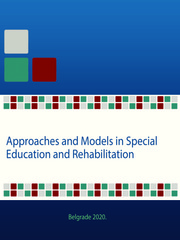Приказ основних података о документу
The advantages of bilingualism of deaf and hard of hearing children
| dc.contributor | Nedović G. | |
| dc.contributor | Eminović F. | |
| dc.creator | Kovačević, Tamara | |
| dc.creator | Đoković, Sanja | |
| dc.date.accessioned | 2021-06-17T14:08:48Z | |
| dc.date.available | 2021-06-17T14:08:48Z | |
| dc.date.issued | 2020 | |
| dc.identifier.isbn | 978-86-6203-139-6 | |
| dc.identifier.uri | http://rfasper.fasper.bg.ac.rs/handle/123456789/3294 | |
| dc.description.abstract | The population of deaf and hard of hearing children is very heterogeneous and, because of this, the existence of different approaches is needed in education in order to meet their communication and educational needs successfully. Hearing and speech impairment leads to certain specificities and difficulties in the development of these children, which requires adequate methods and approaches in the process of rehabilitation and education, and great support and encouragement from the family, the preschool institution, the school and the environment. Results of numerous studies indicate that the best approach in education, for most of the deaf children, is bilingualism, or bilingual approach. Bilingualism is knowledge and regular use of sign and spoken language in deaf and hard of hearing children. Bilingualism of the hearing is different from the bilingualism of the deaf. Bilingual normal hearing children, as well as deaf children, learn two languages. The difference is that they learn a second language through auditory means, in the same modality as a first language. Deaf children learn two languages in two modalities, which is considerably more complex. The basic objective of the paper is to, by reviewing the available literature, point to what the advantages of bilingualism in deaf and hard of hearing children are. Bilingualism is an advantage to typically developing children; likewise, it is an advantage to children with permanent hearing loss, beyond the points raised earlier. Exposure to sign language does not hinder the development of spoken language or any other cognitive development; to the contrary, many cognitive, social, and educational benefits follow from bilingualism. | |
| dc.language | en | |
| dc.publisher | University of Belgrade – Faculty of Special Education and Rehabilitation | |
| dc.rights | openAccess | |
| dc.rights.uri | https://creativecommons.org/licenses/by-sa/4.0/ | |
| dc.source | Approaches and Models in Special Education and Rehabilitation – Thematic Collection of International Importance | |
| dc.subject | bilingualism | |
| dc.subject | advantages | |
| dc.subject | deaf and hard of hearing children | |
| dc.title | The advantages of bilingualism of deaf and hard of hearing children | en |
| dc.type | conferenceObject | |
| dc.rights.license | BY-SA | |
| dc.citation.epage | 303 | |
| dc.citation.epage | ||
| dc.citation.other | : 289-303 | |
| dc.citation.rank | M14 | |
| dc.citation.spage | 289 | |
| dc.description.other | In. G.Nedović & F.Eminović (Eds.), Approaches and Models in Special Education and Rehabilitation- Thematic Collection of International Importance | |
| dc.identifier.fulltext | http://rfasper.fasper.bg.ac.rs/bitstream/id/3147/bitstream_3147.pdf | |
| dc.identifier.rcub | https://hdl.handle.net/21.15107/rcub_rfasper_3294 | |
| dc.type.version | publishedVersion |


